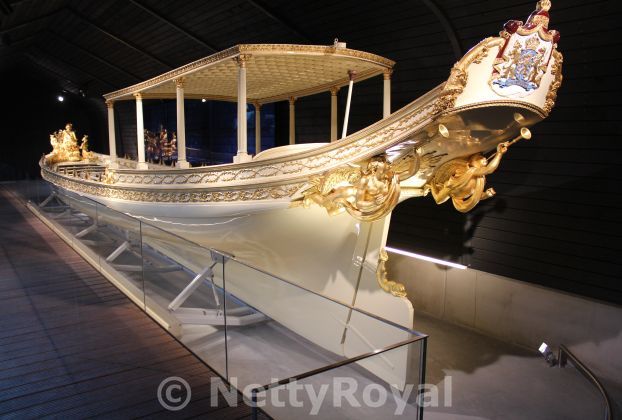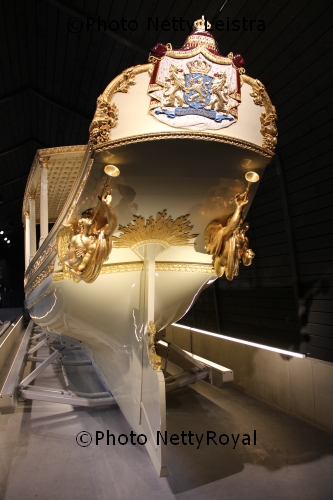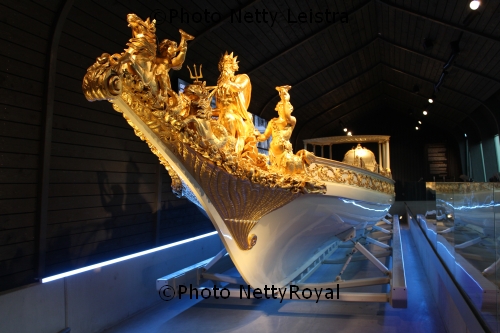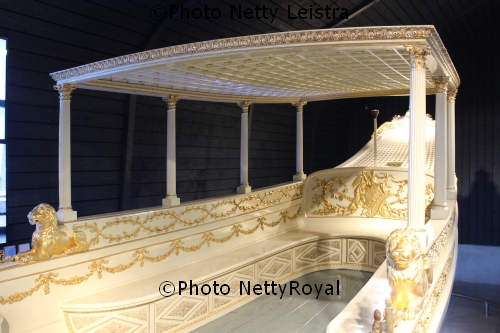Just over 200 years ago the new King Willem I of the Netherlands wished for himself a royal barge, at the time a ‘must have’ if you were a European monarch. The 21-year-old architect Cornelis Jan Glavimans designed the barge and between 1816 and 1818 the royal barge was constructed at the Navy shipyard in Rotterdam. But when it was finally finished the King never made use of it. Only on 30 March 1841, it finally had its maiden voyage, when Willem I’s eldest son and successor King Willem II used it during his investiture celebrations. In the next 150 years the barge – nicknamed “the Golden Carriage of the Water” – the royal barge was only used on 30 occasions. Until 1853 the barge could be found at the Navy shipyard in Rotterdam, afterwards in Amsterdam.
Some important events it was used for were the visit of the Shah of Persia in 1889, the christening of the later Queen Wilhelmina in 1892, the state visit of King Albert I and Queen Elisabeth of the Belgians in 1910, the French state visit in 1911, the state visit of King Christian X and Queen Alexandrine of Denmark in 1914, the state visit of King Haakon VII of Norway in 1954 and the state visit of the Liberian president in 1956. The last time it was officially used was during the Silver Wedding celebrations of Queen Juliana and Prince Bernhard of the Netherlands on 29 April 1962. In 1983 the barge was given to the National Maritime Museum (Scheepvaartmuseum) in Amsterdam as a permanent loan.


In 2007 a comprehensive renovation program of the museum started and after July 2008 the royal barge wasn’t on display at the museum anymore. It was the last piece to leave the museum. The museum reopened in 2011, but there was no space for the barge. With a donation of one million Euros from the BankGiro Lottery, the Cultuur Lottery and input from AkzoNobel the barge was completely renovated and made seaworthy again at the Marine Etablissement in Amsterdam. The hull turned out to be in a perfect condition, as was the oak of the keel and the ribs. However the paint was damaged and yellowed, so the ship was stripped completely and repainted with a fresh layer of paint. X-rays were made of the gilded carved figures and also the rosettes were cleaned, repaired and gilded.
Finally on 7 October 2015 the royal barge was installed in its specially designed boathouse next to the museum’s landing. The official opening with pipers and drummers of the Marine Corps took place one week later, on 14 October 2015. After an absence of eight years the royal barge was again on display at the museum as off 15 October 2015. The barge is officially still royal property. It would be most interesting if the royal family would use the barge once again. Some voices were heard it should have been used for the inauguration of King Willem-Alexander on 30 April 2013, but it wasn’t to be.


The royal barge is 17 meters long and has seats for 20 rowers and can carry quite a few passengers. The barge is decorated with the Roman god of water – Neptune – at the bow, and furthermore with many other mythical creatures and golden ornaments. They symbolize the new king Willem I and the Kingdom of the Netherlands. Neptune is the main feature of the barge. The master of the seas holds his trident and is seated on his shell carriage drawn by three seahorses with the upper body of a horse and the lower body of a fish. The starboard side of the barge is richly decorated on the in- and outside with acanthus vines and orange branches – of course symbolizing the House of Orange-Nassau -, closed off on the front by two reclining lions – that symbolize the monarchy and protect the monarch. The stem, or the rear of the ship, of course displays the Dutch royal coat of arms.
Visitors – like me last week – can nowadays get closer than ever and admire the royal barge in detail. There is a lovely video in the background showing some old footage. The barge looks brand new! And I really hadn’t expected it to be so big.
